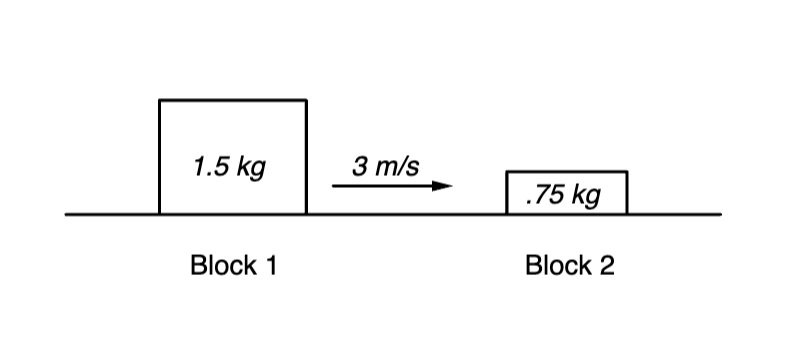A \( 60 \ \text{kg} \) person is riding in an elevator. At time \( t_1 \), the elevator is accelerating downward with a magnitude of \( 2 \ \text{m/s}^2 \). A short time later, at time \( t_2 \), the elevator is accelerating upward with a magnitude of \( 2 \ \text{m/s}^2 \). The ratio of the normal force exerted by the elevator on the person at time \( t_1 \) to that at time \( t_2 \) is most nearly
 The figure above shows a uniform beam of length \( L \) and mass \( M \) that hangs horizontally and is attached to a vertical wall. A block of mass \( M \) is suspended from the far end of the beam by a cable. A support cable runs from the wall to the outer edge of the beam. Both cables are of negligible mass. The wall exerts a force \( F_w \) on the left end of the beam. For which of the following actions is the magnitude of the vertical component of \( F_w \) smallest?
The figure above shows a uniform beam of length \( L \) and mass \( M \) that hangs horizontally and is attached to a vertical wall. A block of mass \( M \) is suspended from the far end of the beam by a cable. A support cable runs from the wall to the outer edge of the beam. Both cables are of negligible mass. The wall exerts a force \( F_w \) on the left end of the beam. For which of the following actions is the magnitude of the vertical component of \( F_w \) smallest?
A golfer hits a shot to a green that is elevated \(2.80 \, \text{m}\) above the point where the ball is struck. The ball leaves the club at a speed of \(18.9 \, \text{m/s}\) at an angle of \(52.0^\circ\) above the horizontal. It rises to its maximum height and then falls down to the green. Ignoring air resistance, find the speed of the ball just before it lands.

Block 2 initially is at rest. Block 1 travels towards block 2 and collides with Block 2 as shown above. Find the final velocities of both blocks assuming the collision is elastic.
Three blocks of masses \(5 \, \text{kg}\), \(4 \, \text{kg}\), and \(3 \, \text{kg}\) are placed side by side in that order. A \(25 \, \text{N}\) force applied on the \(5 \, \text{kg}\) block accelerates all three blocks together to the right. Find the acceleration of the blocks and the normal force the \(4 \, \text{kg}\) block exerts on the \(3 \, \text{kg}\) block.
A rescue plane wants to drop supplies to isolated mountain climbers on a rocky ridge that is \( 235 \) \( \text{m} \) below. The plane is traveling horizontally with a speed of \( 250 \) \( \text{km/h} \). How far in advance of the recipients (horizontal distance) must the goods be dropped?
A 0.035 kg bullet moving horizontally at 350 m/s embeds itself into an initially stationary 0.55 kg block. Air resistance is negligible.
A seesaw is balanced on a fulcrum, with a boy of mass [katex] M_1 [/katex] sitting on one end and a girl of mass [katex] M_2 [/katex] sitting on the other end. The seesaw is a uniform plank of length [katex]L[/katex] and mass [katex] M[/katex]. The fulcrum is located at the midpoint of the plank. Does [katex] M_1 = M_2 [/katex]. Justify your working.
Find the downward acceleration of an elevator, given that the ratio of a person’s stationary weight to their weight in the elevator is \(5:4\).
Three blocks are stacked on top of one another. The top block has a mass of \( 4.6 \, \text{kg} \), the middle one has a mass of \( 1.2 \, \text{kg} \), and the bottom one has a mass of \( 3.7 \, \text{kg} \).
Identify and calculate any normal forces between the objects.

Three forces of equal magnitude are applied to a \( 3 \)-m by \( 2 \)-m rectangle. Force \( F_1 \) and \( F_2 \) act at \( 45^\circ \) angles to the vertical as shown, while \( F_3 \) acts horizontally.
A pendulum bob of mass m on a cord of length L is pulled sideways until the cord makes an angle [katex] \theta [/katex] with the vertical. The change in potential energy of the bob during the displacement is:
By continuing you (1) agree to our Terms of Use and Terms of Sale and (2) consent to sharing your IP and browser information used by this site’s security protocols as outlined in our Privacy Policy.
Quick Start Guide
AP physics 1, AP C, honors and advanced physics students.
Quickly filter questions by units and more.


Here’s guide to using 5 UBQ filters.
GQ = general question, MCQ = multiple choice, FRQ = free response.


Click the check or bookmark button.
Now you’ll be able to see completed or bookmarked questions at a glance!
Answer keys, personalized for you.

Phy will be responsible for grading your FRQs and GQs.
No more copy and pasting. Just solve and snap.
Questions for Mastery

By continuing you agree to nerd-notes.com Terms of Service, Privacy Policy, and our usage of user data.